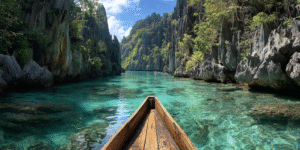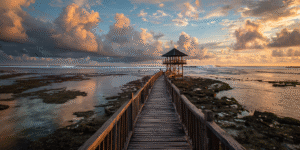Did you know that Cebu is the oldest city in the Philippines? Established in 1565, it’s a place where 500-year-old stone churches stand minutes away from modern cafes and bustling tech hubs. This blend of old and new, urban and natural, is what makes figuring out the best things to do in Cebu such a rewarding challenge. It’s more than just a gateway to the country’s central islands; Cebu is a destination in its own right, offering a dense tapestry of experiences from the mountain highlands to the deep blue sea.
Island Life and Underwater Worlds
Most visitors are drawn to Cebu’s natural landscapes, and for good reason. The island province is a playground for outdoor enthusiasts. In South Cebu, the town of Badian is famous for canyoneering—an adventure that involves hiking, scrambling, and leaping down a series of waterfalls, culminating at the stunningly blue Kawasan Falls. A guided tour is mandatory for safety and costs around ₱1,500–₱2,000 ($25–$34 USD) per person, which includes gear and a guide. A key tip: go on a weekday to avoid the weekend crowds that pour in from the city.
Just a short drive from Badian is Moalboal, a must-visit for one of the most incredible marine spectacles: the sardine run. Here, millions of sardines move in a massive, shimmering ball just meters from Panagsama Beach. You don’t even need scuba gear; a simple snorkel and mask are enough to witness this phenomenon. For certified divers, the nearby Pescador Island offers dramatic wall dives and a chance to see sea turtles and vibrant coral gardens. This is a core part of any good Cebu travel guide.
A Walk Through History and Faith
To truly understand Cebu, you must connect with its past. Start in the heart of Cebu City at the Basilica Minore del Santo Niño de Cebú, the country’s oldest Roman Catholic church. It houses the revered Santo Niño statue, a gift from Ferdinand Magellan to Rajah Humabon’s wife in 1521. A few steps away, you’ll find Magellan’s Cross, a kiosk housing a large wooden cross that symbolizes the arrival of Christianity in the Philippines. Be aware of the respectful dress code when visiting the Basilica—shoulders and knees should be covered.
For a panoramic view of the city and a quieter historical encounter, take a taxi up to the Cebu Taoist Temple in the Beverly Hills subdivision. Built in 1972 by the local Chinese community, its multi-tiered architecture and tranquil gardens offer a peaceful escape. The entrance is free, but remember it’s a place of worship, so maintain a quiet demeanor. Exploring these tourist attractions in Cebu provides a deep sense of the island’s cultural foundations.
Savoring Cebu: From Markets to Lechon
You can’t talk about Cebu without mentioning lechon, the legendary roasted pig with unbelievably crispy skin. While many famous eateries exist in the city, locals often point to the town of Carcar, about an hour south, for the most authentic version. At the Carcar Public Market, you can buy it by the kilo (around ₱800-₱1,000 or $14-$17 USD) and eat it right there with puso (hanging rice).
Beyond lechon, dive into the local food scene at a “dampa” or “sutukil” restaurant. Sutukil is a portmanteau of three Cebuano words: Sugba (grill), Tula (stew), and Kilaw (marinate in vinegar). You pick fresh seafood from a display, and the restaurant prepares it in these three styles. For a truly local market experience, visit the Taboan Public Market, famous for its vast array of dried fish, or “bulad.” The smell is potent, but it’s an authentic slice of Cebuano commerce.
Adrenaline and Altitude
For those seeking a rush, Cebu delivers. On the northern tip of the island, Malapascua Island is one of the few places in the world where you can reliably dive with thresher sharks. These elegant creatures with long, whip-like tails are often seen at Monad Shoal during early morning dives. It’s an unforgettable experience for advanced divers. Many dive shops on the island offer the PADI Advanced Open Water course if you’re not yet certified for deep dives.
If you prefer heights to depths, consider a trip to Osmeña Peak in Dalaguete. Known as the highest point in Cebu, its unique, jagged hills are often compared to Bohol’s Chocolate Hills, but with a sharper edge. The hike to the summit is relatively easy—about 20-30 minutes from the trailhead—and offers breathtaking 360-degree views of both the east and west coasts of the island. It’s one of the most rewarding things to do in Cebu for sunrise or sunset.
Beyond the Main Tourist Trail
Looking for what to do in Cebu that’s a bit different? Consider a visit to Camotes Islands, often called the “Lost Horizon of the South.” It’s a group of islands east of Cebu known for its pristine beaches, freshwater Lake Danao (where you can kayak), and impressive cave pools like Timubo Cave. It requires a ferry ride from Danao Port (north of Cebu City), which is why it remains less crowded than other spots.
Another insider tip is to explore the Bojo River in Aloguinsan, home to an award-winning ecotourism project managed by the local community. A guided cruise on a small outrigger boat takes you through a serene mangrove forest that opens up to the sea. The tour (around ₱650 or $11 USD) includes a local guide explaining the ecology and history of the area, plus a delicious local lunch. It’s a fantastic model of sustainable, community-based tourism.
Essential Travel Tips
Getting around Cebu requires a bit of planning. In Cebu City, ride-hailing apps like Grab are reliable. For longer distances, the Ceres buses at the North and South Bus Terminals are efficient and affordable. A bus ride from Cebu City to Moalboal, for instance, costs around ₱200 ($3.40 USD). The weather is tropical year-round, but the best time to visit is during the dry season from December to May. When visiting waterfalls or going on boat tours, always bring cash in small denominations, as digital payments are rarely an option in rural areas. This is one of the most critical tips for anyone planning things to do in Cebu.
Cebu is an island of incredible diversity, where one day you can be exploring a historic urban core and the next, swimming alongside millions of fish. It’s a place that rewards the curious traveler, the one willing to venture just a little further. The only question left is, which adventure will you choose first?




